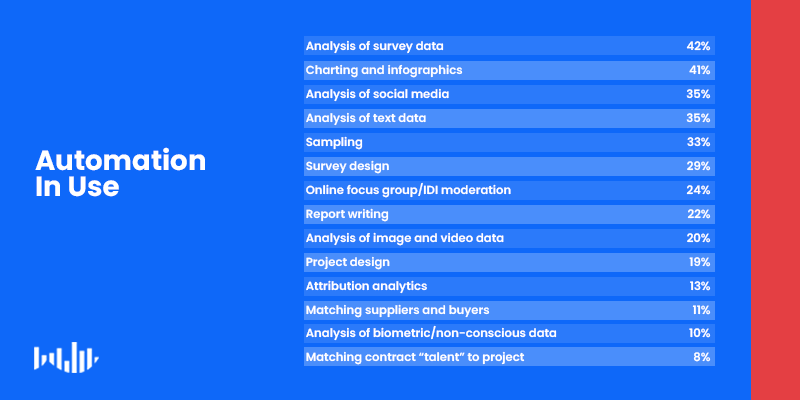Market Research Trends Dominating 2020 — and Beyond
 2020 has seen its fair share of downsides, to put it mildly. But the year has also seen advancements on the market research front. Indeed, there have been several trends coming out of the woodwork or making headway in innovations on existing trends.
2020 has seen its fair share of downsides, to put it mildly. But the year has also seen advancements on the market research front. Indeed, there have been several trends coming out of the woodwork or making headway in innovations on existing trends.
These trends have steadily become forces to reckon with when it comes to collecting research on the markets.
In this article, we’re going to give a rundown on some of the biggest market research trends dominating 2020. These have held a sturdy weight in the space and we foresee them to carry onto the next year(s) due to their magnitude.
The Use of Blockchain for Security, Elimination of Data Silos & More

The advent of the blockchain has powered the cryptocurrency industry — but it hasn’t stopped there. A decentralized ledger system, the blockchain’s first line of storage was cryptocurrency transactions, but it is capable of storing virtually any kind of data.
Due to its immutable nature, all recorded transactions cannot be corrupted or modified in any way. The blockchain also operates in a members-only capacity. It extends security with features such as proof of member identity and verifiable transactions.
Aside from stronger security, blockchain technology provides the following to the market research industry:
Less oversight required, with approved members only using a particular blockchain
No need to deal with additional intermediaries.
Much less prone to hacking due to encryption, peer-to-peer oversight and decentralization.
Better protection for data, as it is stored into blocks and broken down from large databases.
Elimination of duplicate responders, since nodes can identify consumers with their data
Reduction in data silos, since data is decentralized across a network of users
Ease of interoperability between blockchain participants to share data.
The Rise of Machine Learning and Artificial Intelligence
Machine learning has risen over the years in implementations across industries. To put things into perspective, machine learning uses artificial intelligence for gathering patterns to peruse current happenings and predict future behavior.
Using a breadth of algorithms, machine learning stores data to glean customer activities and behaviors, which it uses to predict future customer activities. AI also assists in market research through a number of ways.
Firstly, it has been setting trends in the process of deep learning segmentation. Market segmentation has long been used for developing customer personas in the ad tech, marketing and market research verticals. Deep learning segmentation is a segmentation framework that has been improved by AI, as AI identifies patterns too intricate for humans to understand or make use of without biases.
This way, businesses can both make sense and make use of big data, rather than have it go to waste or not understand it to its maximum potential.
AI has also provided the market research industry with:
Processing large sets of data
Identifying trends within a complex system
Cutting costs by reducing the time to conduct market research
Building up layers of insight for a more precise customer understanding
Performing repetitive and manual tasks faster than humans
Understanding qualitative and quantitative data via Natural Language Processing (NLP)
Eliminating human bias by processing information only
Automation Continues Aiding with New Innovations
Automation is on the rise across multiple industries, to the point where roughly 60% of all occupations contain at least 30% of automatable activity. It is thus no surprise that automation has made its way to the market research industry.
Much like artificial intelligence, automation procedures reduce manual intervention so that more windows of time open up for humans to work on other matters.
For research purposes, automation has revolutionized many researching tasks, with the innovations of social listening, sampling, quota collection, survey distribution and more. These reduce the need for interviewing and searching for survey participants, among other changes.
Here are some of the ways automation serves the MR industry:
DIY survey platforms allow for streamlined aggregation of primary research.
Application of more tech-based, automatable solutions (ex: in-app solutions)
The elimination of the need for sourcing and requesting samples
Survey re-routing so participants only get relevant questions (Ex: if they answered X, they are taken to question Z, skipping a few other questions)
Allowing researchers to more easily handle larger sets of data.
Storage and quick access to a variety of customer data
Sending reminder notifications to participants so that they finish their surveys

The Simplification & Prevalence of Mobile Surveys
The mobile space is growing, both in terms of traffic and app development. As such, the market research industry has pushed surveys to take part in the mobile experience.
Mobile surveys have been significantly making strides, as 30-40% of surveys are completed on a mobile device. With mobile the growing number of mobile users and mobile traffic, this device has lent itself to be a key battleground for rounding up the thoughts of consumers.
Mobile surveys are trending in the MR space, along with some of their own, unique features. Here are a few:
Unique templates to match brands’ style
The capability of granting a white-label feel
Adaptation to a multitude of mobile websites and apps
Short surveys zeroing in sub-niches and subtopics
Seamless integrations within various mobile formats
In-app data analysis
Adoption of a low code platform
Remaining on the Lookout for More Trends
Market research is an expansive practice, neither fixed on one type of research method (primary or secondary). Rather, much like customer expectations themselves, it is constantly evolving and accelerating in some respects.
In order to keep a leg up on your vertical and target market, your business must stay on top of trends in the MR space. This includes emerging trends, along with established ones that are still carrying weight and innovating new sub-trends.
All the aforementioned trends in this article have seen steady popularity in that these tend to be cost-effective, time-saving and quashing of one or several inconveniences. Your business can therefore stand to adapt some of their innovations or practices.
Stay on the lookout for more market research trends. We’re always watchful to provide the latest trends. That way researchers and general business owners can become more competitive and relevant to their target market.
Frequently asked questions
How has blockchain technology improved survey market research?
Blockchain allows for complete control over how surveys are distributed and responded to. When using blockchain technology, a company controls exactly who takes the survey and can prevent any gaming of the system.
What applications does the use of AI have in market research?
AI and machine learning have made it much faster for researchers to process huge amounts of data and identify trends within those data sets. This results in cost and time savings for the research team. It is also used to understand qualitative and quantitative data.
How does automation benefit market researchers?
Automation reduces the amount of work that needs to be done by researchers, freeing up their time to be used for more valuable operations. Additionally, automation can be used to dynamically deliver survey questions to respondents based on their previous answers.
How popular are mobile surveys?
Approximately 30 - 40% of all online surveys are completed on a mobile device.
What are some of the recent trends in mobile surveys?
Mobile survey technology is always evolving. Some of the latest trends include the ability to deploy very short surveys to a sub-niche, in-app data analysis dashboards, and deployment of surveys across a variety of websites and apps.
Do you want to distribute your survey? Pollfish offers you access to millions of targeted consumers to get survey responses from $0.95 per complete. Launch your survey today.
